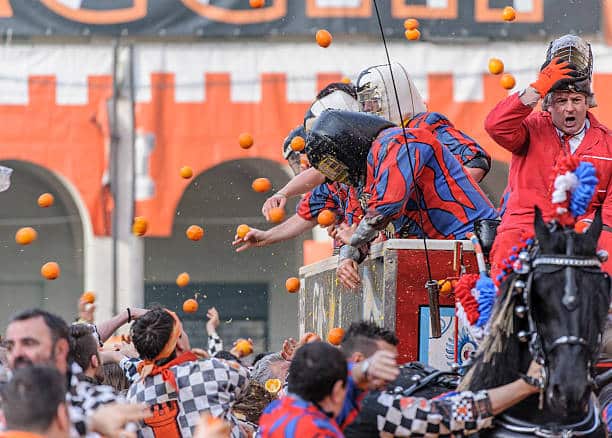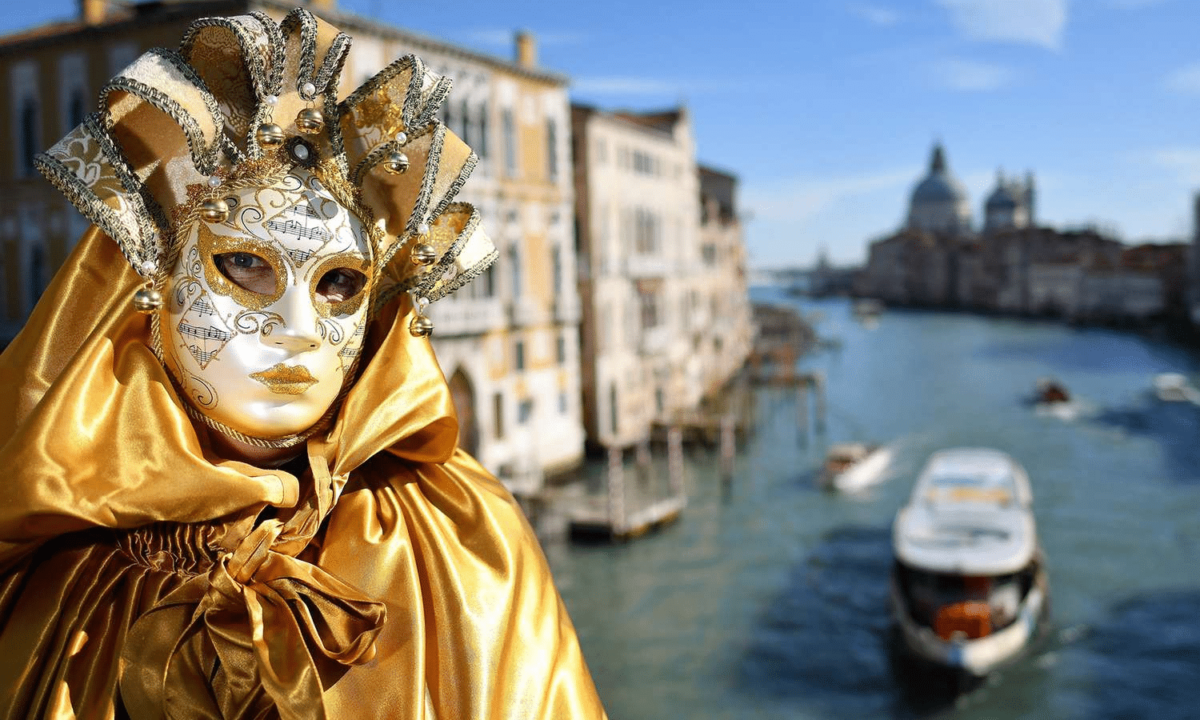The Carnival of Ivrea is a festival in the Northern Italian city of Ivrea, which includes a tradition of throwing oranges between organized groups, known as the Battle of the Oranges. It is the biggest food fight in Italy and surrounding countries. And it is one of the finest carnivals in Europe.
When is the Ivrea Carnival?
The Battle of the Oranges! Ivrea Carnival is a pre-Lenten carnival that lasts from Sunday until Tuesday before Lent.
Why choose this Carnival?
Carnival, also known as the Carnival of the Oranges, is one of Italy’s most historic carnivals. It is held annually before Lent starts in the Piedmontese town of Ivrea.
The Carnival dates to the Middle Ages and is a symbolic representation marking the freedom of Ivrea from oppression, starvation, and tyranny. Ivrea Carnival is one of the world’s most unique and oldest festivals.
Famous in Italy, the historic Ivrea Carnival is an Italian event of international importance. Therefore, Ivrea is described as an area in Italy with great art, history, architecture, and natural beauty.
Carnival first occurred in Ivrea in 1808 because the city’s French administrators combined all the wild celebrations in the town and turned them into one large carnival celebration.
The Battle of the Oranges
The Battle of the Oranges is the highlight and most famous event at the Ivrea Carnival, commemorating the civil war between the people of Ivrea and the Royal Napoleonic Troops, which broke out the day after hated tyrant Raineri di Biandrate, was slain.
The Battle of Oranges is Italy’s most significant food fight that sees over 400 tons of oranges thrown throughout the city’s main streets and squares, symbolizing the people of Ivrea’s right to self-rule. The Battle of the begins on Sunday before Ash Wednesday and ends on Shrove Tuesday.
Beautiful Mugnai (Miller’s Daughter) and the Origins of the Carnival
The show’s real star is the Beautiful Mugnai (Miller’s Daughter), a symbol of freedom and the heroine of the festival since her first appearance in 1858.
According to the legend, the heroism of Violetta, a miller’s daughter, freed the people from tyranny. Violetta killed Violetta with his sword, rebelling against the hated tyrant Conte Ranieri di Biandrate. And the celebrated Battle of the Oranges recalls this uprising. As a sign of their participation in the festival, all citizens and visitors take to the streets wearing the classic Berretto Frigio (Phrygian cap) from Fat Thursday onwards on the orders of the General. This red hat, shaped like a stocking, symbolizes solidarity with the uprising and, therefore, the pursuit of liberty, just as it was during the French Revolution.
The Nine Tribes of Ivrea
The Battle of Oranges is the fight between nine teams divided by district. Each unit has its colors, clothing, and symbols plastered on banners and flags. The teams go around on foot and represent the townsfolk who revolted against Napoleon’s Troops.
When the battle starts, your team’s responsible for defending its territory against the imaginary tyrannical Napoleon troops.
Each of the nine teams has its established location within the city; the Ace of Spades, the oldest team, has their pitch set in the main town square, which it shares with the Aranceri of Death team.
Ottinetti Square is home to the Scacchi and the Scorpions of Arduino teams, while the Borghetto Tuchini throws from the right bank of the Dora Baltea. The Black Panthers, the Devils, and the Mercenaries fight in Piazza del Rondolino, and the last group, the Credendari Aranceri, can be found in Freguglia Square.
The Nine Tribes each have their distinct history and story. Your allegiance to a tribe is similar to your commitment to a football team. You join a team based on district or family/friend allegiances. Once you have entered a group, you support it for life.
How Much Does the Battle of the Oranges Cost?
Ivrea Carnival and the Battle of the Oranges can attend and be a spectator on Monday and Tuesday. However, tickets will cost around €10 on Sunday.
If you want to be an Orange-thrower, you must pay if you are not a native of Ivrea. A participation fee is around €100, though this will also include food, wine, and oranges over the three days of the carnival. First-timers must also purchase a tribe uniform, which will cost around €80. You get to keep the uniform; every year you participate, you can sew a new patch onto it.
Each Tribe has its rules, so check the tribe websites above to see which will let you join. This festival has a high demand, so contact the Tribes to see what they allow.
Battle of the Oranges Top Tips
- Be prepared to be hit by a few oranges: Even if you are spectating, you may find a few oranges accidentally coming your way. If this is not your cup of tea, watch from afar.
- Purchase a spectator hat: If you are only a spectator, you MUST purchase a “berretto frigio” or a Phrygian Hat, a soft red conical cap that costs 5 euros. It symbolizes that you are uninterested in being a target and have oranges pelted at you.
- Anyone can join in, but the demand to join a tribe is high, so we recommend that you reach out to the tribes as soon as possible to secure your place.
- Learn some Italian: Most tribes and their members will only speak Italian. It will be helpful to have some basic Italian phrases under your belt to communicate with your Tribe,
- Follow the rules: Everyone keeps to the rules; don’t throw oranges at horses, people in red dates, or the wrong Tribe. Also, do not throw oranges from a distance. They are only supposed to be thrown from nearby wagons. It is done to avoid hitting unwilling viewers.
- Keep a safe distance from the horses. Never stand behind or close to them, even if they stand still.
- Do not touch the oranges without Tribe permission: Outsiders are not allowed to throw oranges, and you cannot help yourself to Tribe oranges without being qualified.
- Stand behind protection nets: if you are a spectator, stand behind the protection nets to avoid being hit with oranges. Ensure you aren’t too close to them because they won’t protect you if you are too tight.
The conclusion of the Carnival of Ivrea article
The Carnival of Ivrea is as unusual as it is historic. However, we recommend attending it. It offers something different, especially if you don’t mind messy food fights. So, what do you think? We’d like to hear your opinion in the comments below.
Take a look at
References and sources:
Photo credits:
Featured photo: AGaeta








